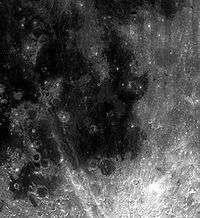Mare Nubium
|
Mare Nubium | |
| Coordinates | 21°18′S 16°36′W / 21.3°S 16.6°WCoordinates: 21°18′S 16°36′W / 21.3°S 16.6°W |
|---|---|
| Diameter | 715 km (444 mi)[1][2] |
| Eponym | Sea of Clouds |
Mare Nubium ("sea of clouds") is a lunar mare in the Nubium basin on the Moon's near side. The mare is located just to the southeast of Oceanus Procellarum.
Formation
The basin containing Mare Nubium is believed to have been part of the Pre-Nectarian system, with the surrounding basin material being of the Lower Imbrian epoch. The mare material is of the Upper Imbrian epoch.
The crater to the west of the mare is Bullialdus,[3] which is of the Eratosthenian Epoch. This means the crater is younger than the mare it sits in. The crater that sits on the southern rim of the mare is Pitatus.
Names
Like most of the other maria on the Moon, Mare Nubium was named by Giovanni Riccioli, whose 1651 nomenclature system has become standardized.[4] Previously, William Gilbert had included it among the Continens Meridionalis ("Southern Continent") in his map of c.1600,[5] and Michael Van Langren had labelled it the Mare Borbonicum (after the House of Bourbon) in his 1645 map.[6]
Exploration
The first released images from the Lunar Reconnaissance Orbiter in 2009 were of the lunar highlands 200 km south of Mare Nubium.[7]
News
In September 2013, Spanish astronomers observed and recorded an impact event when a large rock hit the lunar surface in Mare Nubium[8]
References
- ↑ "Moon Mare/Maria". Gazetteer of Planetary Nomenclature. USGS Astrogeology. Retrieved 2010-08-20.
- ↑ "Mare Nubium". NASA Lunar Atlas. Retrieved 2009-07-04. External link in
|publisher=(help) - ↑ "Observatorio ARVAL - Moon Map". Observatorio ARVAL. Retrieved 2009-07-04.
- ↑ Ewen A. Whitaker, Mapping and Naming the Moon (Cambridge University Press, 1999), p.61.
- ↑ Ewen A. Whitaker, Mapping and Naming the Moon (Cambridge University Press, 1999), p.15
- ↑ Ewen A. Whitaker, Mapping and Naming the Moon (Cambridge University Press, 1999), p.41, 198.
- ↑ Garner, Robert (July 2, 2009). "LRO's First Moon Images". NASA. Retrieved February 16, 2015.
- ↑ "Astronomers spot record-breaking lunar impact". Phys.Org. Retrieved 2014-02-25.
